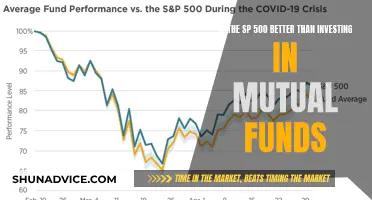
Fidelity is one of the most well-known names on Wall Street, and its mutual funds are among the most respected investment vehicles in the world. The company was established just after World War II and has since become one of the top five largest fund families globally.
Fidelity mutual funds are suitable for a range of investors, from those who want a hands-free approach to those who want to pick and choose funds to build a portfolio. The funds are known for their solid active management and relatively low costs.
When it comes to the best Fidelity funds to invest in, there is no one-size-fits-all answer as it depends on your personal risk profile, investment timeline, and capital. However, some general rules of thumb can help separate the good from the bad.
Key Considerations for Fidelity Funds:
- Established and Liquid Fund: Look for funds with a minimum of $8 billion in assets under management, indicating stability and liquidity.
- Reasonable Fees: Mutual funds tend to be more expensive than ETFs, but choose funds with no additional transaction fees and low expense ratios.
- Investment Style: Consider your investment style and goals. Some funds focus on growth, income, or a blend of both.
- Diversification: Diversify your portfolio by investing in funds with different investment strategies, such as large-cap, mid-cap, small-cap, value, or growth funds.
- Performance and Risk: Evaluate the fund's performance and risk profile to ensure it aligns with your investment objectives and tolerance for risk.
Examples of Top-Performing Fidelity Funds:
- Fidelity 500 Index Fund (FXAIX): This fund tracks the S&P 500 index, providing access to large-cap stocks like Microsoft and Apple. It has a low expense ratio of 0.015%.
- Fidelity Large Cap Growth Index Fund (FSPGX): This fund takes a growth-oriented approach, investing in companies with expanding sales and profits. It has a slightly higher expense ratio of 0.035%.
- Fidelity OTC Portfolio (FOCPX): This fund offers exposure to innovative and non-traditional companies listed outside the NYSE, including the tech-heavy Nasdaq exchange.
- Fidelity Select Semiconductors Portfolio (FSELX): A focused fund investing in companies engaged in the design, manufacture, and sale of electronic components like semiconductors.
- Fidelity Investment Grade Bond Fund (FBNDX): A stable and reliable fund investing in high-quality, investment-grade assets, primarily U.S. Treasury and government-backed mortgage entities.
- Fidelity Floating Rate High Income Fund (FFRHX): This fund invests in floating-rate loans, which offer the advantage of being linked to current and future interest rates.
- Fidelity Balanced Fund (FBALX): A one-stop shop fund with a mix of about 60% stocks and 40% bonds, providing a balanced approach for investors who want both growth and income.
What You'll Learn

Fidelity 500 Index Fund
The Fidelity 500 Index Fund (FXAIX) is one of the best Fidelity funds to invest in. It is the third-largest US mutual fund in terms of net assets, with a 10-year average annual return of 13.0% and a 1-year average annual return of 27.1%. The fund has a low expense ratio of 0.015% (or 0.02% according to another source), which means that nearly all the underlying returns benefit fund shareholders.
The fund invests in all S&P 500 stocks, which include leaders in each of the 11 economic sectors that meet size, profitability and liquidity requirements. Cumulatively, S&P 500 companies account for 80% of the value in the US public stock market. The S&P 500 has grown about 7% annually on average after inflation, making FXAIX a good choice as a sole equity position or as a core holding in a more complex allocation.
For example, an investor holding $10,000 worth of FXAIX can expect to incur just $1.50 in fund fees annually. This fund is also one of Fidelity's longest-tenured offerings, with an inception date of February 17, 1988. Since its launch, FXAIX has delivered an 11.04% annualized return.
Chanakya Opportunities Fund: A Smart Investment Strategy
You may want to see also

Fidelity Large Cap Growth Index Fund
The Fidelity Large Cap Growth Index Fund (FSPGX) is one of the best Fidelity mutual funds to invest in. Here's why:
Overview
FSPGX is a large-cap growth portfolio that tracks the Russell 1000 Growth Index. This index includes stocks within the large-cap Russell 1000 that have higher price-to-book ratios, optimistic growth outlooks from analysts, and relatively high sales per share growth over the past five years. As of October 23, 2024, FSPGX had total assets of $28.2 billion and an expense ratio of 0.035%.
Performance
The fund has delivered strong performance, with a lifetime average annual return of 18.1% since its inception in 2016. As of October 2024, its 1-year average annual return was 30.8%. Over the last one and five-year timeframes, FSPGX outperformed the S&P 500 index fund, although the S&P 500 had a slightly higher average return over the past three years.
Advantages
FSPGX targets large companies with growth characteristics, and its overlap with the S&P 500 makes it a good choice for investors seeking exposure to large-cap stocks with growth potential. The fund's low expense ratio of 0.035% is also advantageous, as it allows more of the underlying returns to benefit fund shareholders. Additionally, FSPGX has a Morningstar Medalist Rating of Silver, indicating a strong management team and sound investment process.
Considerations
While FSPGX offers attractive features, it's important to consider the overall investment goals and risk tolerance when making decisions. The fund's performance may fluctuate, and it may not always outperform the S&P 500, as evident by the slightly higher average return of the S&P 500 over the past three years. Therefore, it's essential to assess the fund's performance relative to its peers and consider the level of risk that aligns with your investment strategy.
Exchange-Traded Funds: A Smart Investment Strategy?
You may want to see also

Fidelity Magellan Fund
The Fidelity Magellan Fund (Mutual fund: FMAGX) is perhaps the world's best-known actively managed mutual fund, known for its record-setting growth under the management of Peter Lynch from 1977 to 1990. The fund averaged over a 29% annual return during this period, making it the best-performing mutual fund in the world.
Peter Lynch created the investment process commonly referred to as "Buy What You Know". He proposed that the average person is just as capable of identifying good stocks as a Wall Street professional, and noted that many of his best stock picks came from his experiences with a company as a customer. Lynch bucked many prevailing trends on mutual fund investing, such as buying many more stocks than usual. In 1989, Magellan held an unheard-of 1,400 stocks.
Under Lynch's management, the fund grew from $18 million in assets under management (AUM) to $14 billion. However, the fund was not open to the public until mid-1981, with only the Johnson family able to invest in it before this point. The largest growth of the fund occurred under Lynch's management, but it was also the only regime where Magellan underperformed the market.
After Lynch, the fund was managed by Morris Smith, Jeffrey Vinik, Robert Stansky, Harry Lange, and Jeffrey S. Feingold. The fund was closed to new investors from 1997 until 2008, as it was believed that the size of the fund was beginning to make it difficult to beat the market. In 2021, an ETF version of the fund was launched, managed by Tim Gannon and Sammy Simnegar.
Understanding Investment Fund Dividends: Where Do They Come From?
You may want to see also

Fidelity Zero Large Cap Index Fund
The Fidelity Zero Large Cap Index Fund (FNILX) is one of the best Fidelity mutual funds to invest in. It is a zero-expense-ratio index mutual fund, meaning it charges a 0% expense ratio, making it free to invest in. This fund is ideal for investors who want to keep costs low.
FNILX is a large-cap fund, tracking just over 500 large-cap U.S. stocks via the proprietary Fidelity U.S. Large Cap Index. It has a similar overall composition to the Fidelity 500 Index Fund (FXAIX) but does not track small-cap stocks. To achieve its 0% expense ratio, FNILX lends securities to generate income and offset costs.
FNILX has a Morningstar "economic moat" rating superior to its peer group and index. This means that Morningstar analysts believe the fund's holdings will be able to fend off rivals for the next 10 years due to factors like network effect, intangible assets, cost advantage, switching costs, and economies of scale.
FNILX has delivered strong returns, outperforming its stablemate, the Fidelity Zero Total Market Index Fund (FZROX), during the prior one, three, and five years. Top holdings include well-known companies such as Microsoft, Apple, Nvidia, Amazon, Alphabet, Meta, Berkshire Hathaway, and Eli Lilly.
The Fidelity Zero Large Cap Index Fund is a good choice for investors seeking a low-cost, well-diversified fund with strong historical performance and a favourable outlook for the future.
Oil Fund Investment: A Smart Move?
You may want to see also

Fidelity Zero Total Market Index Fund
The Fidelity Zero Total Market Index Fund (FZROX) is one of the best Fidelity funds to invest in. Here's what you need to know about it:
Overview
The Fidelity Zero Total Market Index Fund (FZROX) is a mutual fund that offers investors exposure to a broad range of publicly traded companies in the US. The fund seeks to provide investment results that correspond to the total return of the US stock market, including large-, mid-, and small-capitalization stocks. This means that by investing in FZROX, you will get access to a diversified portfolio of US stocks of different sizes and across various sectors.
Performance
FZROX has delivered competitive returns over the years. Over the past year, the fund has returned 8.55%, while over the past three and five years, it has returned 9.30% and 10.27%, respectively. These returns are higher than the category averages, indicating that FZROX has outperformed similar funds.
Fees and Minimum Investment
One of the biggest advantages of investing in FZROX is its low cost. The fund has a 0% expense ratio, which means that there are no management fees. Additionally, there is no minimum investment required, making it accessible to investors with varying financial capabilities.
Risk
According to Morningstar, the risk associated with FZROX is average compared to other funds in the same category. The fund has a broad, passive nature, resulting in tax efficiency due to its low portfolio turnover rate. This makes it a decent holding for investors who have reached their contribution limits in their tax-advantaged accounts.
Comparison with Similar Funds
When choosing a mutual fund, it is essential to compare similar funds to make an informed decision. FZROX is similar to the Fidelity Total Market Index Fund (FSKAX). Both funds offer exposure to a wide range of US stocks, but FZROX has the advantage of a 0% expense ratio, making it a more cost-effective option.
In conclusion, the Fidelity Zero Total Market Index Fund (FZROX) is a strong choice for investors seeking broad exposure to the US stock market. With competitive returns, low fees, and no minimum investment, it offers a cost-effective way to diversify your portfolio and invest in a wide range of US companies.
Mutual Fund Self-Investment: A Guide to Getting Started
You may want to see also
Frequently asked questions
The Fidelity ZERO Large Cap Index Fund (FNILX) is a good option for beginner investors as it has zero annual management fees and invests in large-cap companies. Another option is the Fidelity 500 Index Fund (FXAIX), which is a simple and affordable way to gain exposure to large blue-chip stocks.
Yes, the Fidelity U.S. Sustainability Index Fund (FITLX) is a large-cap ESG index fund that has outperformed its large-cap blend Morningstar category over the past one, three, and five years.
The Fidelity Investment Grade Bond Fund (FBNDX) is one of the firm's oldest and most respected ways to invest in fixed-income markets. It focuses on "investment-grade" assets from credit-worthy entities, providing stability and reliable yields.
The Fidelity Balanced Fund (FBALX) invests about 60% of its assets in stocks and 40% in bonds, making it a good option for investors who want a mix of growth and income.







